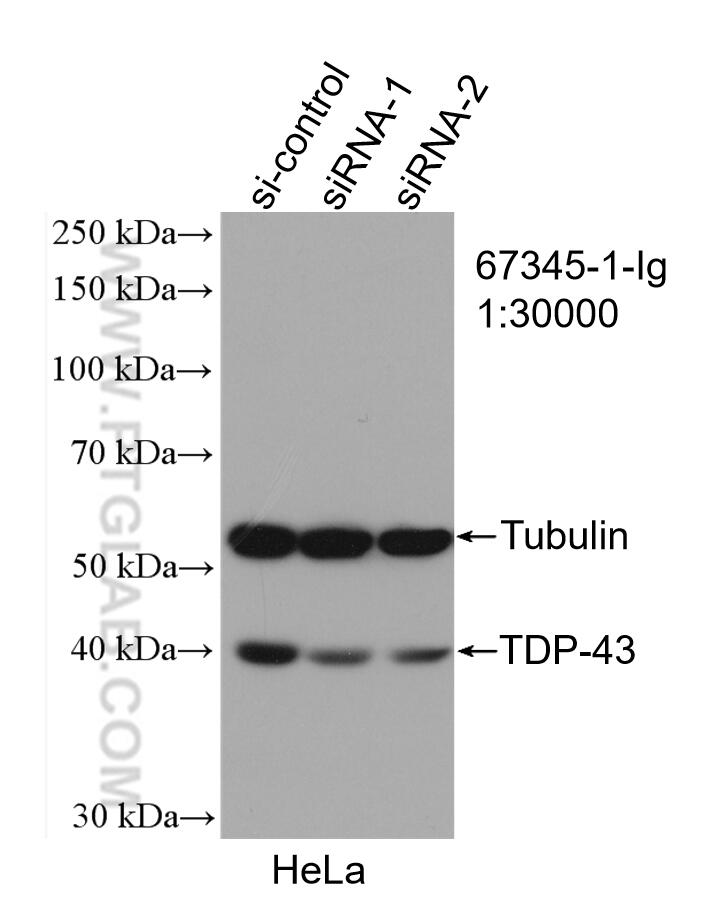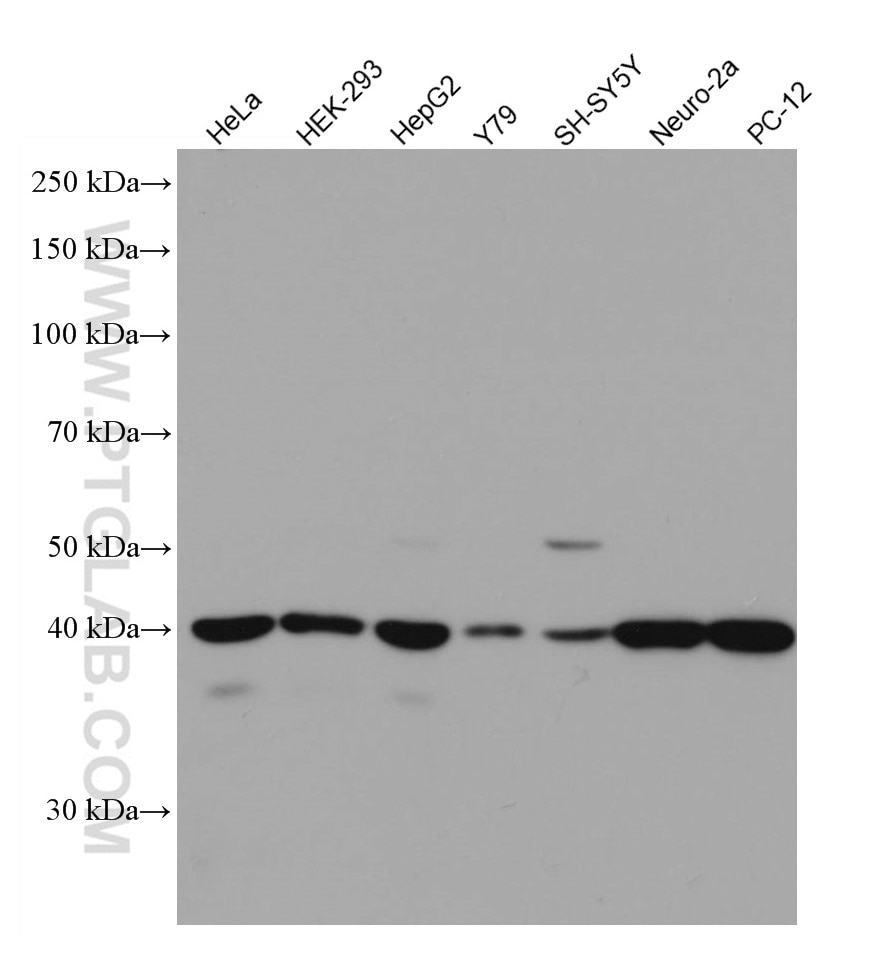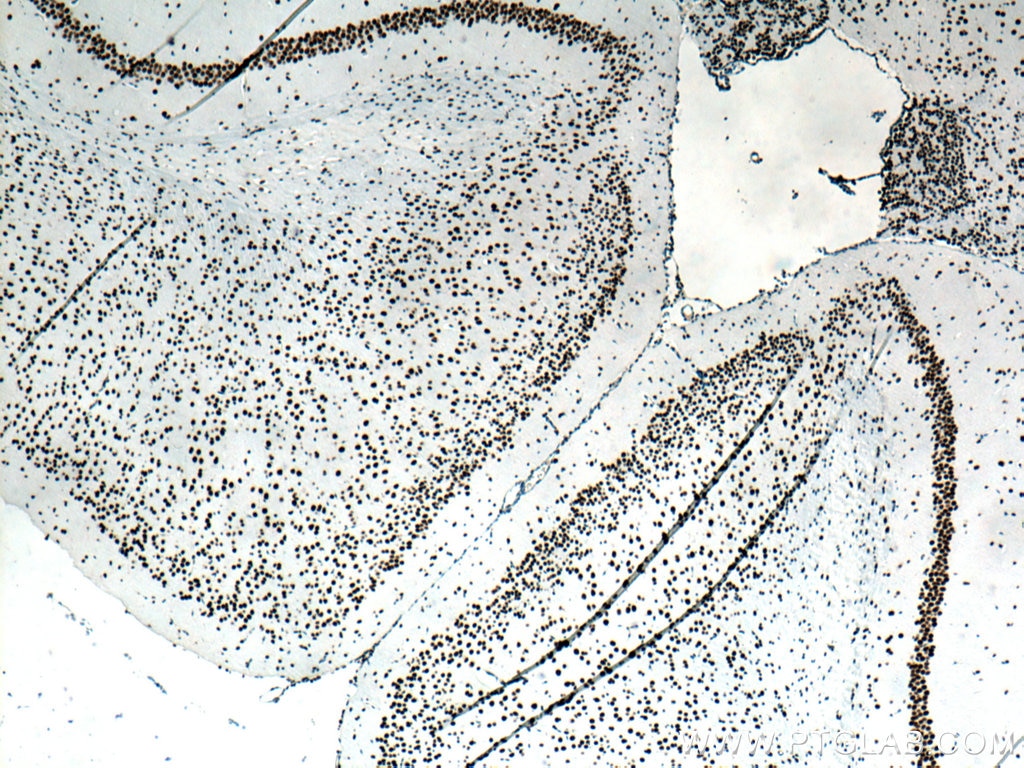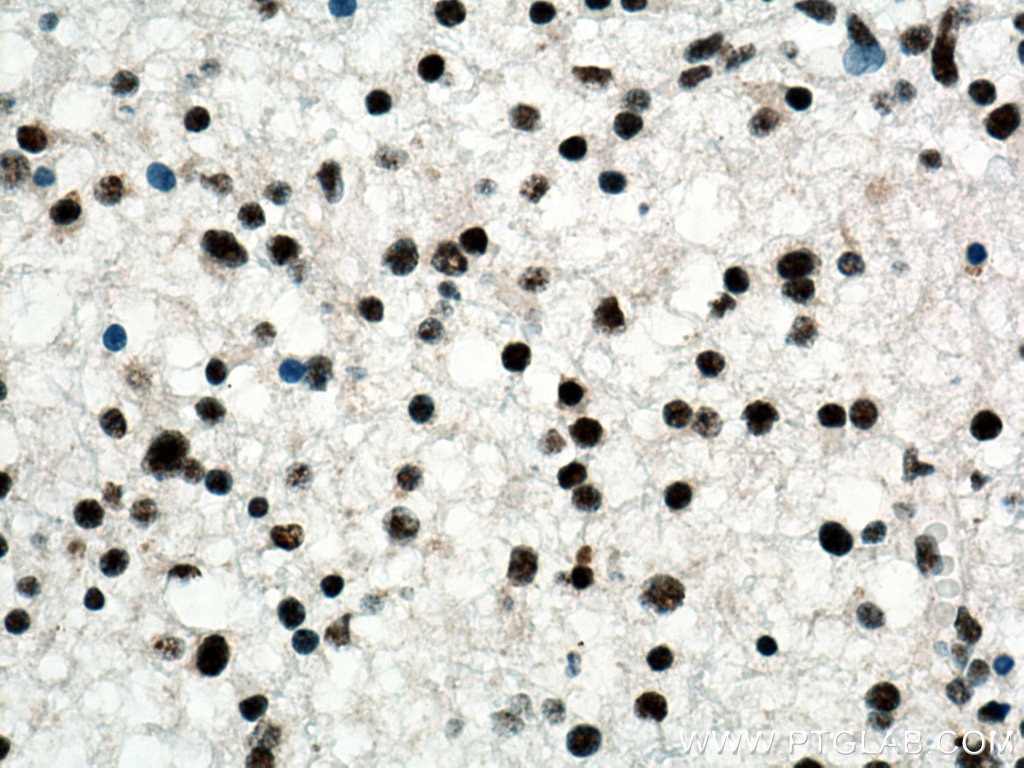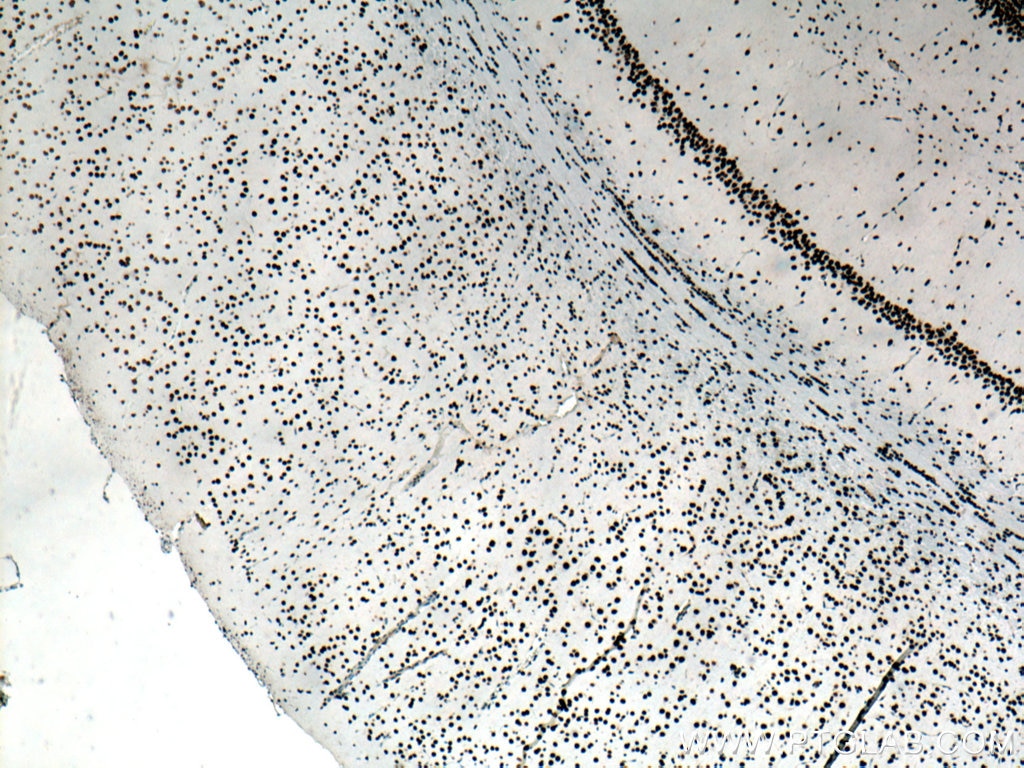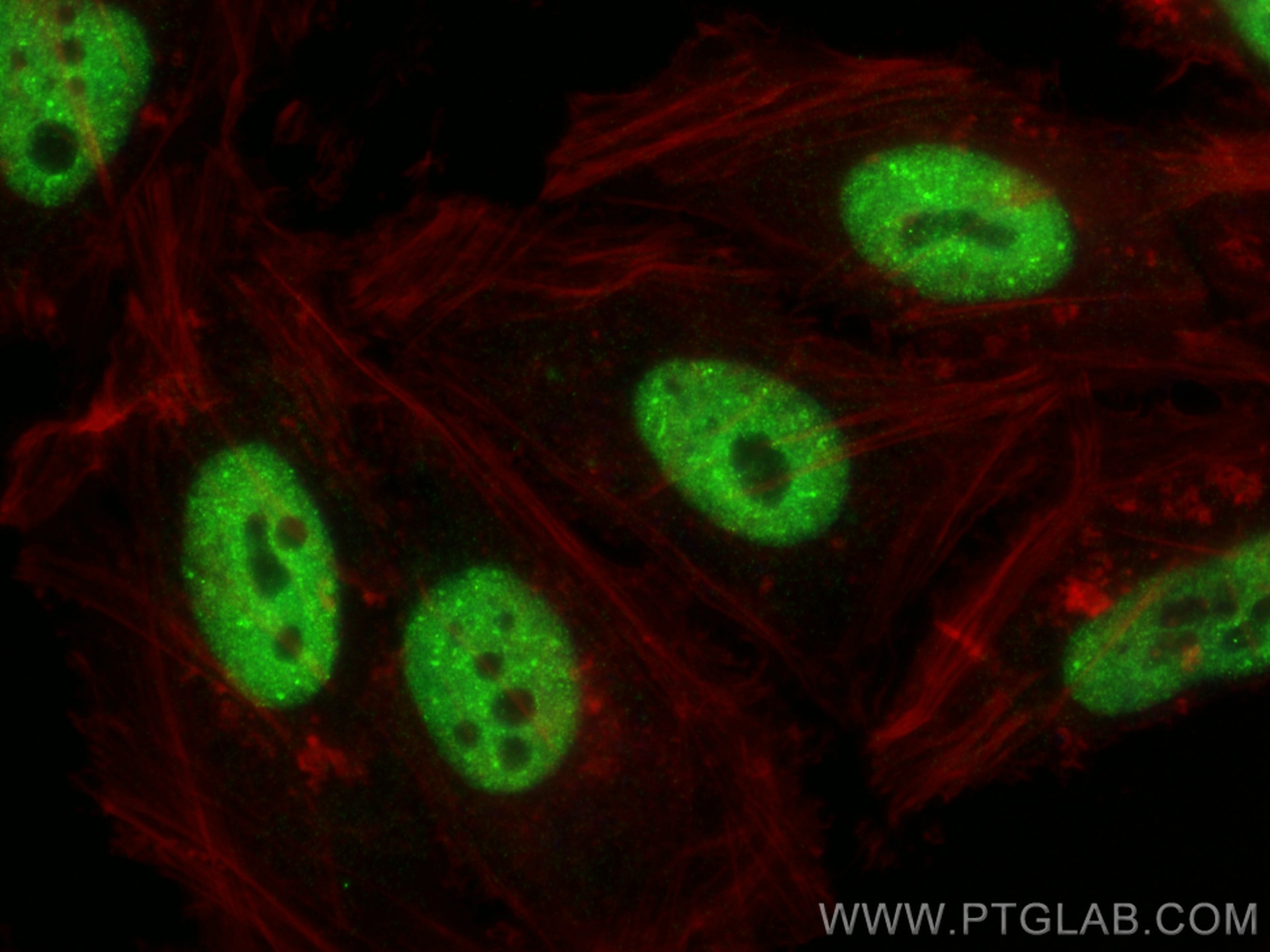- Featured Product
- KD/KO Validated
TDP-43 (C-terminal) Monoklonaler Antikörper
TDP-43 (C-terminal) Monoklonal Antikörper für WB, IHC, IF/ICC, IF-P, ELISA
Wirt / Isotyp
Maus / IgG2a
Getestete Reaktivität
human, Maus, Ratte
Anwendung
WB, IHC, IF/ICC, IF-P, ELISA
Konjugation
Unkonjugiert
CloneNo.
1G5F6
Kat-Nr. : 67345-1-Ig
Synonyme
Geprüfte Anwendungen
| Erfolgreiche Detektion in WB | HeLa-Zellen, HEK-293-Zellen, HepG2-Zellen, Neuro-2a-Zellen, PC-12-Zellen, SH-SY5Y-Zellen, Y79-Zellen |
| Erfolgreiche Detektion in IHC | Maushirngewebe, humanes Gliomgewebe, Rattenhirngewebe Hinweis: Antigendemaskierung mit TE-Puffer pH 9,0 empfohlen. (*) Wahlweise kann die Antigendemaskierung auch mit Citratpuffer pH 6,0 erfolgen. |
| Erfolgreiche Detektion in IF-P | Rattenhirngewebe |
| Erfolgreiche Detektion in IF/ICC | HeLa-Zellen |
Empfohlene Verdünnung
| Anwendung | Verdünnung |
|---|---|
| Western Blot (WB) | WB : 1:5000-1:50000 |
| Immunhistochemie (IHC) | IHC : 1:2000-1:20000 |
| Immunfluoreszenz (IF)-P | IF-P : 1:250-1:1000 |
| Immunfluoreszenz (IF)/ICC | IF/ICC : 1:400-1:1600 |
| It is recommended that this reagent should be titrated in each testing system to obtain optimal results. | |
| Sample-dependent, check data in validation data gallery | |
Veröffentlichte Anwendungen
| WB | See 4 publications below |
| IF | See 6 publications below |
Produktinformation
67345-1-Ig bindet in WB, IHC, IF/ICC, IF-P, ELISA TDP-43 (C-terminal) und zeigt Reaktivität mit human, Maus, Ratten
| Getestete Reaktivität | human, Maus, Ratte |
| In Publikationen genannte Reaktivität | human, Maus |
| Wirt / Isotyp | Maus / IgG2a |
| Klonalität | Monoklonal |
| Typ | Antikörper |
| Immunogen | Peptid |
| Vollständiger Name | TAR DNA binding protein |
| Berechnetes Molekulargewicht | 43 kDa |
| Beobachtetes Molekulargewicht | 43-45 kDa |
| GenBank-Zugangsnummer | NM_007375 |
| Gene symbol | TDP-43 |
| Gene ID (NCBI) | 23435 |
| Konjugation | Unkonjugiert |
| Form | Liquid |
| Reinigungsmethode | Protein-A-Reinigung |
| Lagerungspuffer | PBS with 0.02% sodium azide and 50% glycerol |
| Lagerungsbedingungen | Bei -20°C lagern. Nach dem Versand ein Jahr lang stabil Aliquotieren ist bei -20oC Lagerung nicht notwendig. 20ul Größen enthalten 0,1% BSA. |
Hintergrundinformationen
Transactivation response (TAR), DNA-binding protein of 43 kDa (also known as TARDBP or TDP-43), was first isolated as a transcriptional inactivator binding to the TAR DNA element of the HIV-1 virus. Neumann et al. (2006) found that a hyperphosphorylated, ubiquitinated, and cleaved form of TARDBP, known as pathologic TDP-43, is the major component of the tau-negative and ubiquitin-positive inclusions that characterize amyotrophic lateral sclerosis (ALS) and the most common pathological subtype of frontotemporal lobar degeneration (FTLD-U). 67345-1-Ig is a mouse monoclonal antibody raised against the C-terminal region of human TDP-43.
Protokolle
| PRODUKTSPEZIFISCHE PROTOKOLLE | |
|---|---|
| WB protocol for TDP-43 (C-terminal) antibody 67345-1-Ig | Protokoll herunterladen |
| IHC protocol for TDP-43 (C-terminal) antibody 67345-1-Ig | Protokoll herunterladenl |
| IF protocol for TDP-43 (C-terminal) antibody 67345-1-Ig | Protokoll herunterladen |
| STANDARD-PROTOKOLLE | |
|---|---|
| Klicken Sie hier, um unsere Standardprotokolle anzuzeigen |
Publikationen
| Species | Application | Title |
|---|---|---|
Biomedicines TDP-43 Pathology and Prionic Behavior in Human Cellular Models of Alzheimer's Disease Patients. | ||
ASN Neuro Casein Kinase 2 Mediates HIV- and Opioid-Induced Pathologic Phosphorylation of TAR DNA Binding Protein 43 in the Basal Ganglia | ||
Front Mol Neurosci TTBK1 and CK1 inhibitors restore TDP-43 pathology and avoid disease propagation in lymphoblast from Alzheimer's disease patients | ||
Neurobiol Dis CHCHD10S59L/+ mouse model: Behavioral and neuropathological features of frontotemporal dementia | ||
Neurobiol Dis Casein kinase 1 inhibitor avoids TDP-43 pathology propagation in a patient-derived cellular model of amyotrophic lateral sclerosis |
